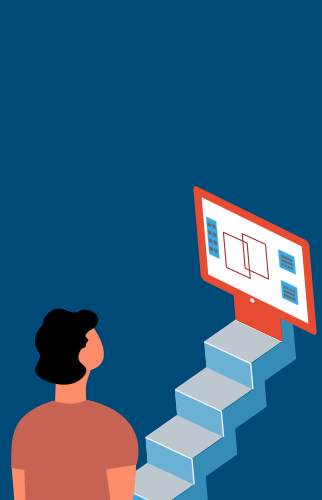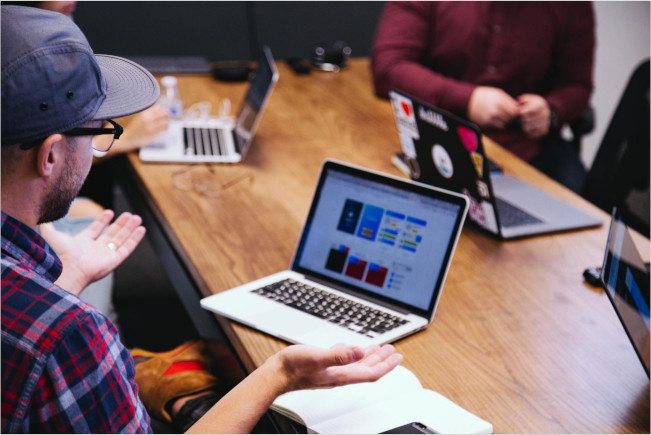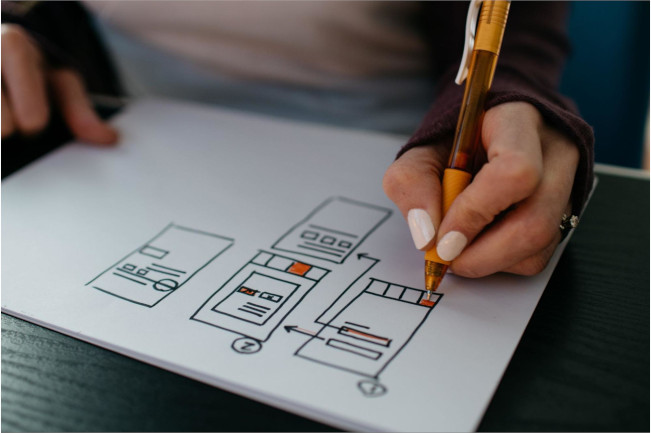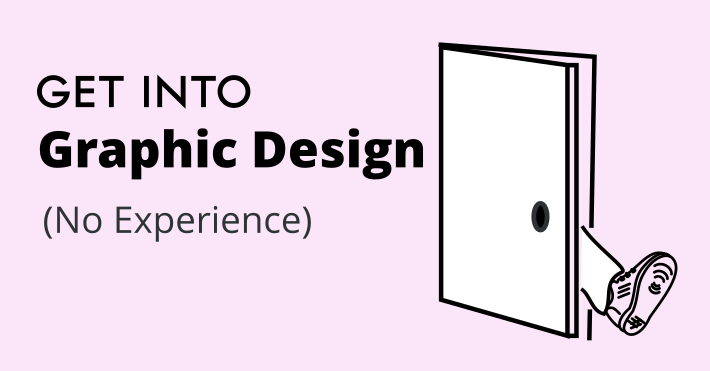Getting into a profession when you have no experience or are straight out of college can be challenging and scary.
It’s like a chicken-and-egg problem: You need experience for getting your first graphic design job but you can’t get experience without having the job in the first place.
In reality, in order to get into graphic design you need leverage. We tend to think that the only way to get leverage is through “real” graphic design work.
However, as a beginner graphic designer who wants to get into the profession, there are other ways you can use to get leverage and confidence.
In this post, I discuss the following 11 realistic ways that will help you get into graphic design with no experience and even land your first graphic design job.
- Join Graphic Design Communities
- Maintain your Online Presence
- Network with Other Designers
- Do Volunteer Projects
- Find an Apprenticeship
- Get a Graphic Design-Adjacent Job
- Build Up Your Portfolio
- Choose a Niche and Build It Out
- Take on Small Projects
- Land a Professional Internship
- Leverage Your Network
Read on.
MY NEW ONLINE COURSE
Thinking Like a Designer
Learn my proven method to finally understand the rules of any design and jumpstart your path to become an effective graphic designer

Getting Into Graphic Design Requires Leverage
How, then, do you get into graphic design if you have no experience?
Simply put, to get into graphic design without real-life experience you need to start accumulating leverage in ways other than paid work in the field. You can acquire leverage in the field by doing free or volunteer work, getting a job that is close to actual graphic designers, or by becoming active in graphic design communities.
By slowly acquiring leverage, you will build-up your confidence, start developing your portfolio, and familiarize yourself with how the field works.
Leverage, then, is your gateway into the profession of graphic design. One important aspect you need to understand about leverage is that it is cumulative.
In other words: The first “leverage points” you can get will lead you to greater gains in leverage as you move forward, provided that your are actively using any previous leverage to build upon your current (and future) leverage.
For example:
When you go up a staircase, how do you get to the top?
By climbing each step.
In other words, you can’t climb to a higher step before stepping on a lower step, etc.
It’s the same with leverage:
Your first “leverage points” will be the bottom steps, but you will use those “steps” for actually climbing on to the next, higher steps. The more you do this, the higher you will get in your leverage hierarchy.
This is how it would be like in terms of graphic design:
- You start out by doing free or volunteer work
- You do this enough as to improve your skills and build your confidence
- This confidence leads you to put your best work on an online portfolio
- This portfolio helps you land your first paid gig from a client you found through a friend or family member (everyone knows someone who needs graphic design, believe me!)
- Rinse and repeat
This is the idea:
Build leverage through ways that aren’t necessarily paid work in the field and start from there.
Below I discuss in detail 11 realistic steps you can take to get you into graphic design and perhaps even land you your first gig.
Realistic Ways to Get into Graphic Design
The following steps should help you get your foot on the door of graphic design.
1. Join Graphic Design Communities
One of the best ways to get into graphic design is to literally get into graphic design communities. There are a lot of bustling graphic design communities on platforms like DeviantArt, Reddit, Instagram and Facebook.
Being part of these communities puts you directly into “the scene,” where you’ll be able to connect with people who can act as role models, mentors, collaborators, and friends. This strategy isn’t just focused on how to get graphic design experience; It’s about how to get experience being a graphic designer.

In these communities, you’ll get to see what other designers are working on and post your own stuff for feedback. You’ll also find discussions about graphic design trends, working in the field, getting graphic design jobs, and the best tools and software to use.
You might not get a job directly through an online community (though it’s possible! There are lots of online job boards for graphic designers, and you can find good ones through designer communities), but you can find great opportunities to network, build your portfolio, learn what it’s really like to work as a graphic designer, and learn how to vet potential clients and employers.
2. Maintain your Online Presence
Being part of online graphic design communities isn’t a “set it and forget it” strategy. You need to actively maintain your presence in these communities, and that means continually posting new work, commenting on others’ work, and participating in discussions. By doing this, you’re keeping yourself “top of mind” in the community and demonstrating that you’re passionate about graphic design.
Once you get that first graphic design job, you might not have time to post your own projects as consistently as you’d like. That’s perfectly fine! Stay active in graphic design communities by answering others’ questions, sharing your experiences, and offering constructive feedback on others’ work.
3. Network with Other Designers
As mentioned above, one of the greatest benefits you’ll find in online graphic design communities is the opportunity to network with other designers. In the broad sense, networking just means “talking shop,” and includes things like:
- Asking and answering questions
- Course, product, and software recommendations
- A sounding board for opinions on how to handle different scenarios that arise as a designer
- Honest, constructive feedback from experienced designers
- Referrals to clients and collaborators
Remember how we mentioned leveraging your network in a recent post?
The designers you network with become your network.
Don’t think of them as competitors; Think of them as collaborators and referral sources. Today, you might be asking for referrals and leads.
A year or two from now, you might be the one giving referrals and leads.
4. Do Volunteer Projects
If you’ve got a graphic design resume with no experience, a fast way to start getting experience is to do volunteer projects. Reach out to your friends, family members, and any other communities you’re part of (church, social clubs, local volunteer organizations) and offer your graphic design services for free.

Once these projects are in your portfolio, nobody needs to know you did them for free. And even though you might not get a paycheck from these projects, you can probably get a referral or testimonial if you ask for one. (Hint: definitely ask for one.)
5. Find an Apprenticeship
Going beyond volunteer work, you can make an apprenticeship your entry point to the graphic design field.
An apprenticeship is usually more focused on shadowing an experienced designer and teaching you all the technical skills you need to succeed as a graphic designer. An apprenticeship can be different from an internship (see below), since the latter can be more professional in nature and may entail real workplace responsibilities, such as solving challenges that arise on the job.
If you’re currently in school, talk to your career guidance office to see if your school has internship programs. If so, use this resource to find an apprenticeship.
If you’re not currently in school, finding an apprenticeship may take a little more work on your part. Ask around your network (that network of other designers you cultivated by joining online communities) for leads on internships or apprenticeships.
You can also search for them on job boards and through platforms like LinkedIn.
6. Get a Graphic Design-Adjacent Job
Another way to immerse yourself in the graphic design world is to get a graphic design-adjacent job.
Here’s what we mean: if you don’t have enough experience or a strong enough portfolio yet to get hired as a graphic designer, apply for jobs at agencies and in marketing departments that aren’t design jobs. These could be receptionist roles, administrative roles, or even department assistant roles.
Any job that brings you into the graphic design studio and has you working with designers directly can act as a launchpad toward a graphic design career of your own. Through your non-design job, you’ll meet designers and potentially open a door to shadow them and even apprentice under them.
Keep in mind that these steps are things to do concurrently, not consecutively. In other words, don’t stop maintaining your online presence as a designer once you land an internship or get a design-related job.
As a newbie designer, think of breaking into the industry as your career right now.
Don’t let yourself become complacent or fall into a routine that doesn’t push you to keep growing…you’re building and branding a business here, even if your goal is to eventually work in-house at a design agency or in an employer’s marketing department.
Thinking of your design career as a business keeps you in a growth mindset, which makes you a valuable asset to any client or employer who works with you.
Get a Graphic Design Job With No Experience
The following next steps can help you get your first graphic design gig or job.
7. Build Up Your Portfolio
The only way to get experience as a graphic designer is to do graphic design. So if you want to get a job as a graphic designer, do projects—“real” and practice projects.
By “real,” we mean projects for clients. This can be paying clients and volunteer work…maybe you can design your friend’s wedding invitations or create a few graphics for your church’s website.
Prospective clients looking at your portfolio don’t need to know whether you got paid for a project or did it pro bono—they just need to see what kind of work you’ve done before and how you’ve created designs that fit clients’ brands perfectly.
Your portfolio should make clients feel confident about working with you, and the more you have in your portfolio, the more confident they’ll feel.
Practice projects count too! Create spec pieces for brands you like and even completely original works. Remember, your portfolio needs to showcase your:
- Creativity
- Technical design skills
- Ability to communicate concepts
If you’re having a hard time landing client gigs, don’t let that stop you from working on your portfolio. Become your own client and design for yourself. After all, you’ve got a personal brand (even if your ultimate goal is to work in-house at an agency or as part of an employer’s marketing team).
Your website, business cards, and social media profiles are all great places to showcase your graphic design skills.
8. Choose a Niche and Build It Out
For graphic designers, there are two different ways to niche:
- Niching in an industry
- Niching in a project type
For example, you might want to niche in the automotive industry. To make yourself appealing to clients in this field, fill your portfolio with projects like website designs, marketing graphics, social media content and logo designs that would work for an automotive brand.
Or you can niche in a project type. You might decide you want to focus on website design or logo design. Instead of doing all kinds of projects for one industry, you do one kind of project for a variety of industries. For example, let’s say you decide to focus on website design. Your portfolio will end up being all the websites you’ve designed, but for clients in different fields.
Niching can help you get a graphic design job because it’s an easy way to show prospective clients what you’re good at. It also demonstrates that you understand a specific industry (or a specific type of project) and all of the nuances and challenges that come with working in that space.
It can also help you connect with specific clients more easily—if you brand yourself as a website designer, people looking for website designs will be able to easily find you through Google searches and on platforms like 99designs and LinkedIn.
Niching isn’t the be-all, end-all of getting graphic design jobs, though. Even if you do niche, you’ll likely end up taking jobs for projects outside your niche every now and then.
You also don’t necessarily need to niche to find work—plenty of successful graphic designers market themselves as generalists and do a ton of business. But when you’re first starting out, choosing a niche can be helpful because it’s a way to focus your marketing efforts.
9. Take on Small Projects Through Platforms Like Fiverr And 99designs
It might sound like we’re repeating ourselves with this tip, but this tip isn’t about practicing graphic design. It’s about practicing working as a graphic designer.
A mindblowing portfolio doesn’t mean you have the skills to be a successful, working graphic designer. Just like it’s necessary to master technical skills like composition and color theory to become a strong designer, you need to master skills like negotiation, time management, accurately pricing projects, and interfacing with clients if you want to be compensated fairly and employed consistently.
This is true whether you plan on working in-house or as a freelancer. As a creative professional in any setting, it’s crucial that you know how to:
- Accurately value your time and skills—for freelancers, this is how you determine your hourly rates and project costs. For in-house designers, it’s how you negotiate your salary and any other compensation you receive
- Listen to how clients describe their project goals and transform these goals into design
- Effectively communicate your thoughts, questions, and any challenges you’re facing to the client (or, if you’re working as an in-house designer, to your supervisor)
10. Land a Professional Internship
An internship is a more entry-level program that teaches holistic skills like how to operate in a workplace environment and how to problem-solve challenges that arise on the job. Many times, a company may have internship positions that must be filled. This can make internships competitive in nature.
Internships in the field are a great way for designers to get professional experience under their belts while building their portfolios. If you’re still in school, your school likely has an internship program in place. Talk to your advisor or a guidance counselor about participating in this program, which often involves you being placed with an employer that has a relationship with your school, then working with that employer for a specified period of time, like one semester or three months.
[IMG: Photo by Mimi Thian on Unsplash]
Typically, internships also have an evaluative component, where your academic advisor might meet with the employer to discuss and evaluate your performance. Internships may be completed for college credit, and in some cases, they lead to paid employment with the company.
If you’re not in school, it can be a bit tougher to find an internship. But there are plenty of internship opportunities available, and you can find them online in places like:
- Indeed
- Glassdoor
Some internships are paid; others are not. In either case, an internship is essentially a job that’s meant to teach you how to work effectively in the environment in which you’re interning.
An internship is a very effective way of getting professional leverage.
11. Leverage Your Network
Don’t forget the value of your network. Your network—your classmates, coworkers, friends, neighbors, and family—can be the key to landing that first graphic design job. However, they can only help you if they know you’re looking for graphic design work.

So tell them. Next time you’re with your friends, ask them if anybody they know needs design work done. Similarly, ask your family members if they know of any job openings for graphic designers or if they might be able to put in a good word for you with their employer.
It doesn’t need to be a formal request; just let your network know that you’re looking for a graphic design job. They might surprise you… you never know who’ll make the introduction or referral that leads to you landing that first job.
Conclusion: Start Building Your Leverage to Get Into Graphic Design Quicker
I have given you 11 realistic ways you can implement to get your foot on the door of professional graphic design.
It won’t be easy. But remember:
You can’t get leverage all at once and as a strike of luck.
You have to build your leverage step-by-step, brick by brick. The more you take steps on building your leverage and confidence, the more momentum you’ll get and the stronger your leverage will become.
You only need to get your foot on the door.
Hang in there! You can do this!
MY NEW ONLINE COURSE
Thinking Like a Designer
Learn my proven method to finally understand the rules of any design and jumpstart your path to become an effective graphic designer


